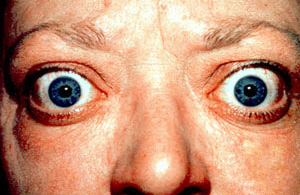Graves' disease
| Graves' disease | |
|---|---|
| Synonym | Flajani–Basedow–Graves disease |
 |
|
| The classic finding of exophthalmos and lid retraction in Graves' disease | |
| Classification and external resources | |
| Specialty | Endocrinology |
| ICD-10 | E05.0 |
| ICD-9-CM | 242.0 |
| OMIM | 275000 |
| DiseasesDB | 5419 |
| MedlinePlus | 000358 |
| eMedicine | med/929 ped/899 |
| MeSH | D006111 |
Graves' disease, also known as toxic diffuse goiter, is an autoimmune disease that affects the thyroid. It frequently results in and is the most common cause of hyperthyroidism. It also often results in an enlarged thyroid. Signs and symptoms of hyperthyroidism may include irritability, muscle weakness, sleeping problems, a fast heartbeat, poor tolerance of heat, diarrhea, and weight loss. Other symptoms may include thickening of the skin on the shins, known as pretibial myxedema, and eye bulging, a condition caused by Graves' ophthalmopathy. About 25% to 80% of people with the condition develop eye problems.
The exact cause is unclear; however, it is believed to involve a combination of genetic and environmental factors. A person is more likely to be affected if they have a family member with the disease. If one twin is affected there is a 30% chance the other twin will also have the disease. The onset of disease may be triggered by stress, infection, or giving birth. Those with other autoimmune diseases such as type 1 diabetes and rheumatoid arthritis are more likely to be affected. Smoking increases the risk of disease and may worsen eye problems. The disorder results from an antibody, called thyroid stimulating immunoglobulin (TSI), that has a similar effect to thyroid stimulating hormone (TSH). These TSI antibodies cause the thyroid gland to produce excess thyroid hormone. The diagnosis may be suspected based on symptoms and confirmed with blood tests and radioiodine uptake. Typically blood tests show a raised T3 and T4, low TSH, increased radioiodine uptake in all areas of the thyroid, and TSI antibodies.
...
Wikipedia
